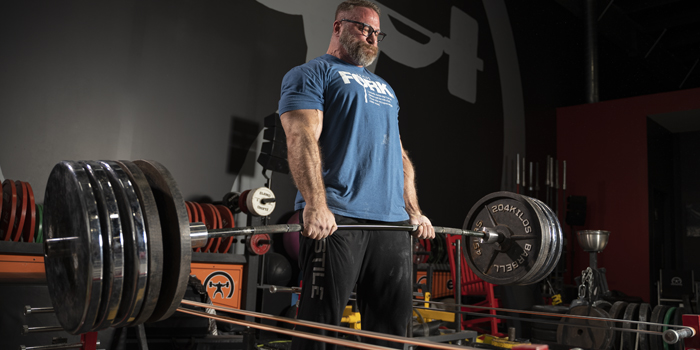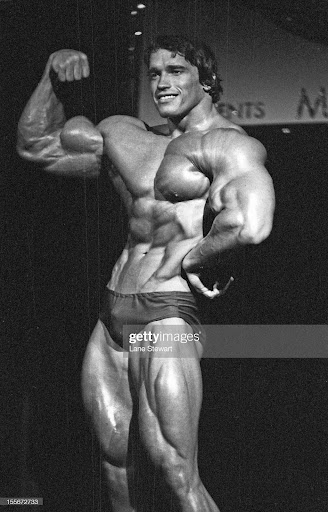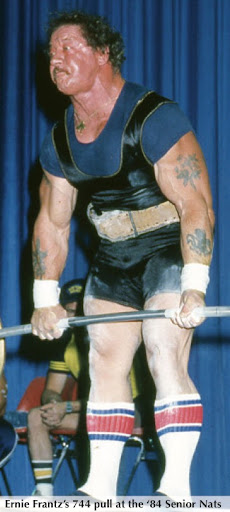
A marriage between the precision of technique and the barbarity of unharnessed power and strength is what the best deadlifters possess.
Over the decades, I have lived in a number of different towns and cities, eleven to be exact. Some moves were when I was a child and related to my dad's job promotions, some related to my education; undergraduate school, graduate schools, and some moves resulted from my work, life, and job advancements.
Of all the places I have lived, two stick out in my mind for their linguistic vernacular and colloquialisms. These two are New Orleans, Louisiana, and the southernmost part of Illinois. These two areas have a lexicon that pulls from colloquialisms from simpler times when certain words painted a detailed and perfect picture of something.
There is More Than One Way to Skin a Cat
"There is more than one way to skin a cat" is the phrase that is such a picture painting way of saying that there are many ways to do something to achieve a given or desired result. As lifters of weight, builders of muscle, seekers of strength, power, and size, "There is more than one way to skin a cat," is applicable to so much of what we do in the gym. There are often many different ways to build power, strength, power, muscle, and size.
If you were to ask John Q. Public something universally related to weights or muscle or size, to that layperson what might immediately jump to their mind is a flexed biceps. Universally known and iconic in vision, if someone says that they work out, often the layperson's response is "show me your muscle."

With regard to big biceps, this historically recognized symbol of strength and muscular development, "there is more than one way to skin that cat." There is more than one way to go about building the biceps. One doesn't need to be a Larry Scott or Robby Robinson as even the most novice of lifters could rattle off some methods to achieve this—standing barbell curls, preacher curls, single-arm dumbbell curls, seated incline dumbbell curls, cable curls, concentration curls, drag curls, hammer curls, lying inclined cambered bar curls, 21's, etc.
When it comes to the deadlift, there are also a number of ways to skin that cat as well. However, when it comes to the deadlift, there is more to building the deadlift than variety, and there is also a point of diminishing returns to consider.
RECENT: The Gravitas of Dave Draper
Although the deadlift is one of the ultimate big three lifts, there are nuances involved, critically important nuances that are often overlooked. There are considerations for the lifter to ponder and weigh about the ways to build strength and power in this lift.
Based on my life experience under the bar with some 30 years of competitions and 40 years in the world of weights under my belt, there are commonly preached methods touted as deadlift building movements that are better left alone. They're better left alone as the benefit to risk ratio is not in the lifter's favor.
Deficits to Build to the Deadlift
Additionally, as the deadlift is a leverage-based movement associated with maximum effort attempts, the deficit deadlift is a movement that requires caution and a good deal of years in the game, and a full understanding of the mechanics involved. Deficit deadlift is not just some grip-it-and-rip-it approach to improving one's overall deadlift.
Over my decades in this most amazing world of strength, power, muscle, and size, I have worked and trained with some of the pound-for-pound best deadlifters ever to grace the platform. Their attention to detail regarding this most brute strength of lifts was something that they all had in common. I recall as if it were yesterday the legendary Ernie Frantz working with us (conventional pullers) and really putting the time and energy into teaching this simple in appearance but, in reality, amazingly complex lift.
The Duality of the Deadlift
In my experience, what makes the deadlift so fantastically simple yet simultaneously complex is its duality. The duality of the deadlift is the fact that it is a marriage of two opposites that work together symbiotically, which makes these two aspects the yin and yang of the conventional deadlift.
Technique
The first ingredient in this symbiotic merger is the technical aspects of the deadlift that must be executed with calibrated exactness. The technique utilizes the proper angles, pivot points, torque, and equilibrium of balance to bring the most out of the fulcrum and lever aspect of this ageless compound movement.
Aggression
The second ingredient in this symbiotic merger is the sheer ravenous aggression involved in this lift. It's the mental requisite to know the bar is coming off the floor and being metaphorically willing to die on the platform while relentlessly pulling until that weight is locked out. It's the ability to Let Johnny Out Of The Bag—five to eight or so seconds it takes to pull a slow grinder off the floor, bring it to lockout, and then set it back down in a controlled manner. If scaled up in size and scope, that grinder would be the NASA equivalent of the tork requisite to shake the bolts loose from a Saturn 5 rocket. The five to eight or so seconds of gear grinding metal on metal effort requires your entire soul to be absolutely and unyieldingly committed to bringing this deadlift to successful fruition.
It is that marriage between the precision of technique and the barbarity of unharnessed power and strength that only the best deadlifters possess. Only the best pullers, as one without the other either, leaves weight on the platform or leaves the lifter injured. It is that plain and simple, and anyone who has pulled big weights for decades knows this. There is also a world of difference between a couple of big pulls in the gym for those socialookatmedia types and a lifetime of big pulls when it matters during competition.
This relationship between these two halves of the lifter, the technical and the aggressive, is a relationship that is constantly being balanced, measured, calibrated, and re-calibrated.
This is the dichotomy when it comes to the deficit deadlift, where the lifter's intellectual prowess or lack thereof plays a critical role.
When it comes to the deficit deadlift, if the lifter's technique is lagging, the deficit aspect will only amplify nagging technical issues, which spells danger for the strength athlete. If I have seen it once, I have seen poor to average deadlifters utilizing deficit pulls in hopes to enhance their already technically deficient pull a hundred times.
In these far too many to count cases, before they know it, their lumbar vertebrae are shot. The discs and pads that need to be healthy to deal with the substantial pounding that a big squat and big deadlift puts on them over the decades are already compromised, and their race is over before the starting gun has even been fired.
Over the decades in this sport, there is a vast powerlifting wasteland strewn with what once were promising deadlifters who missed their opportunity at greatness only to sacrifice it at the altar of bad lifting, poor movement choices, not heeding the technical, and over-embracing the intensity aspect of lifting. Intensity without the technical is just a Kawasaki Ninja H2R driven by a novice rider.
Observe the novice put that machine full throttle, take off like a rocket, and crash head-on into the first turnwall they encounter. There's too much tork and too little know-how. This is the scenario you get with a movement that has the body in a position where the back is at a vulnerable angle, but the grip and rip mentality is still the focus.
The idea of the deficit is to hit an angle below the actual angle of the competition deadlift and to make that portion of the back strong(er). The issue here is there is often no leverage at that angle. This is especially true for a taller deadlifter (tall deadlifters who are practically bent over with the traditional deadlift due to their height). Further, the technical aspect of the lift has been altered, the back is in a vulnerable position, and pretty much all lifters train this movement with far too much weight to achieve what they originally started doing this movement for in the first place.
Just because one can dumbbell press with 135-pound dumbbells for pec development doesn't mean they can train dumbbell flyes with 135-pound dumbbells for pec development. But, that is the template some deadlifters use with regard to the deficit. They use this method as a staple to their training and apply a heavy regular deadlift approach to this compromised angle movement.
There is a vast arsenal of movements to train this portion of the back without compromising the integrity of the deadlifter's back for those who lack the technical prowess requisite for this movement. I would submit that of them all, the deficit gives the least bang for the buck. I say that as unlike a rack pull or elevated deadlifts, which movements that are in the actual path the deadlift would pass through, there is no real-life direct application to this deficit range of motion.
In my experiences with some of the best deadlifters ever to pull on a meet platform, this movement is not a realistic option for most lifters who are not elite level and highly technically proficient. It is absolutely not a realistic movement for the taller lifter who is already stooped over with their regular deadlifts.
Have you ever seen those 500-pound deadlifters who lift the weight, lock it out, then slam the weight onto the platform to impress their 200 IG followers? We all have, as the landscape of the wannabe-instafamous is littered with them. To them, all you can say is, "Congratulations…you just blew off the entire eccentric part of the lift." It makes no sense to train like that, and neither does using this deficit method if you are not already a highly technical puller.
Using the deficit deadlift as a major component in our arsenal to train the back at a disadvantaged angle when other movements build the same area but without the stress, wear and toll on the lower-lumbar region is not the path to a great deadlift.
More often than not, Robert Frost is right on the money about, "the path less traveled makes all the difference." Still, that is not the case with the deficit deadlift and the non-polished deadlifter, as that path leads to a dead-end road. The difference is the deadlifter ultimately suffers as nothing on the powerlifter or strength athlete's body takes a beating each week as the back. As you know, the combination of heavy squats and deadlifts is the bedrock of the sport of powerlifting.
Unlike the squat and bench press, which due to the dynamics of those lifts produce kinetic energy during the initial down phase of the weights, the deadlift is void of kinetic energy. Posture and technique are even more important, and why the deadlifter's back must always be in the proper position when pulling.
My cautionary tale is this: over the decades, I have trained alongside a number of 700- and 800-pound deadlifters, and as a lifter, they have all experienced the same thing, for the minor positives they gained out of this movement, they ended up with far more negatives.
"There is more than one way to skin a cat," and more than one way to build a bigger and better deadlift. Do so by building that back in a way that does not put a disproportionate amount of torque on that vulnerable area.

Deadlift to Build the Deadlift
I reflect on my friendship and the coaching of Ernie Frantz often.
At 198 pounds, Ernie pulled a massive 777-pound deadlift using a 1980s era deadlift bar (no super-thin deadlift bars back then) when he was in his mid-40s. He would share with the Frantz Team in the 1990s that nothing builds a deadlift like simply deadlifting. That was sound powerlifting advice from a powerlifter's powerlifter and advice I share with those of you looking to pull three-and-a-half or four-and-a-half times bodyweight or 700-800 pounds, depending on your bodyweight.
Although technology and some powerlifting equipment has changed/advanced since I got that great training advice, what remains a constant is that plain old straight weight deadlifting for the sake of building the deadlift has, is, and will continue to be the brick and mortar that builds a huge deadlift.
Wishing you the best in your training and meet prep. Ever Onward.
Eric Maroscher is the owner of the Monster Garage Gym. Cofounded by Phil Daniels, NFL Defensive End, Monster Garage Gym is a premier powerlifting gym in the United States. Eric is the leader of the Maroscher Powerlifting Team, a two-time WPC World Powerlifting Champion, two-time APF National Powerlifting Champion, WPC North American Powerlifting Champion, and a multi-time APF Illinois State Champion.











1 Comment